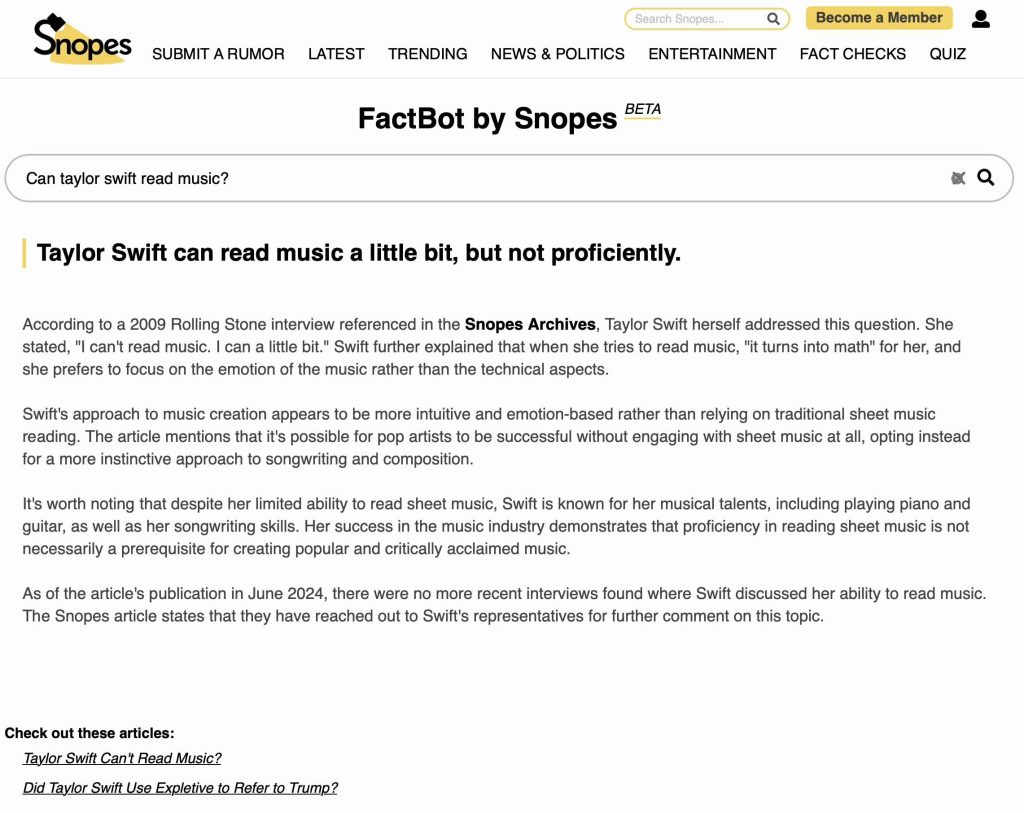Snopes.com integrates a generative AI FactBot to improve user interactions with existing content

Overview
The Cal Poly Digital Transformation Hub (DxHub), powered by Amazon Web Services (AWS), partnered with Snopes.com to explore how Generative AI could enhance user interactions with existing content. The goal was to leverage AI to summarize and answer questions based on Snopes’ extensive repository of fact-checked articles, ultimately improving the user experience and providing new insights for future content.
Problem and Opportunity
Generative AI is increasingly becoming an integral part of our digital lives, particularly in how it can synthesize and provide information from vast amounts of content. Snopes, known for its meticulous fact-checking and extensive database of articles, saw an opportunity to use Generative AI to make it easier for users to find and understand the information they seek. By implementing a system that matches user queries with existing articles, Snopes aimed to deliver precise answers and reduce the time users spend searching for relevant information.
Solution
As part of the prototype, the team ingested Snopes’ article texts into Amazon Simple Storage Service (S3). Incoming articles were sent to Amazon SQS (Simple Queue Service) which managed the processing queue, while AWS Lambda functions embedded the article contents using Amazon Bedrock and the Amazon Titan Text Embedding model. These embeddings were then stored in Amazon OpenSearch Service for fast and efficient retrieval.
Once the articles were stored in OpenSearch, the team built a REST interface using API Gateway, which invokes a Lambda function with a user’s question. The query is then sent to Amazon’s Titan Text embedding model and a similarity search is conducted on the vector store. The system then utilizes Amazon Bedrock and Anthropic’s Sonnet 3-5 model to process the request and generate a concise, accurate summary. The system also records when a question is asked without data to support a comprehensive answer. In this case, the system responds that it doesn’t have enough information to respond and avoids hallucinating an answer. These missed questions are tracked for the Snopes team to review to look at trends for new content.

Supporting Documents
| Source Code | All of the code and assets developed during the course of creating the prototype. |
| Architecture Diagram | A diagram that describes the technical components needed to implement the solution. |
Conclusion
By integrating Generative AI, Snopes can now provide users with accurate, citable sources while minimizing the risk of AI hallucinations. This innovative approach not only enhances the user experience but also helps Snopes identify emerging trends and areas for new content. The partnership with DxHub and AWS has enabled Snopes to leverage cutting-edge technology to maintain its position as a trusted source of information in the digital age. We are excited to announce this feature is now live on Snopes.com.
About the DxHub
The Cal Poly Digital Transformation Hub (DxHub) is a strategic relationship with Amazon Web Services (AWS) and is the world’s first cloud innovation center supported by AWS on a University campus. The primary goal of the DxHub is to provide real-world problem-solving experiences to students by immersing them in the application of proven innovation methods in combination with the latest technologies to solve important challenges in the public sector. The challenges being addressed cover a wide variety of topics including homelessness, evidence-based policing, digital literacy, virtual cybersecurity laboratories and many others. The DxHub leverages the deep subject matter expertise of government, education and non-profit organizations to clearly understand the customers affected by public sector challenges and develops solutions that meet the customer needs.
